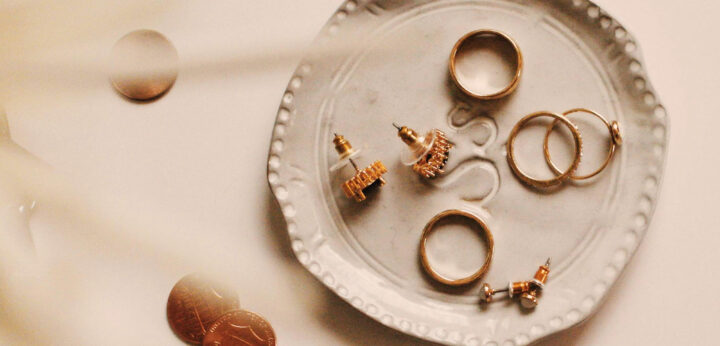Table of Contents
How does renters insurance cover jewelry?
Your renters insurance policy provides personal property coverage, which protects your jewelry from damage and theft. If your jewelry is stolen or damaged, your renters insurance provider will reimburse you for your financial loss up to your policy’s limit.
However, your insurer will only pay for damage or loss caused by covered perils, such as theft or fire damage. Other types of damage and everyday wear-and-tear aren’t covered.
Your payout depends on the type of renters insurance policy you have. If you have a replacement cost policy, your insurer will pay for a brand-new replacement for your lost items. If you have an actual cash value policy, they’ll pay whatever your jewelry was worth when you lost it, taking into account how much the items depreciated since you bought them.
Many policies feature jewelry sub-limits
Like other high-value belongings such as watches, furs, and semiprecious stones, jewelry is usually subject to a sub-limit, which is a cap on the maximum payout you can receive for it. Jewelry sub-limits typically range from $1,000 (as in Progressive and State Farm’s standard policies) to $2,500 (as in Nationwide’s).
Some sub-limits also restrict how much your provider will pay for a single item. For instance, your policy might provide $1,500 in coverage for your entire jewelry collection, but only $500 for each individual piece.
Your jewelry sub-limit might only apply to theft
Sometimes sub-limits only apply to certain perils. It’s relatively common for insurance companies to place sub-limits on jewelry theft, but no sub-limits on how much they’ll pay for jewelry that you lose to other perils, like fires. Check your policy to see exactly what your jewelry sub-limit applies to.
What types of jewelry does renters insurance cover?
Renters insurance covers all kinds of jewelry, including:
- Wedding and engagement rings
- Bracelets and anklets
- Earrings
- Necklaces
- Crowns and tiaras
- Watches
- Brooches and pins
- Cufflinks
It also covers precious and semiprecious stones, such as:
- Diamonds
- Amethysts
- Sapphires
- Emeralds
- Rubies
- Opals
- Pearls
- Topaz
- Peridots
- Garnets
- Turquoise
- Lapis lazuli
When does renters insurance not cover jewelry?
Renters insurance doesn’t cover jewelry if the damage or loss wasn’t caused by a covered peril.
Commonly excluded types of jewelry damage
Unfortunately, renters insurance doesn’t cover most of the everyday accidents that can damage your jewelry, like chipping or dropping it. It also doesn’t cover ordinary wear and tear, stones falling out of their settings, or the loss of your jewelry due to your own negligence.
Renters insurance also excludes many types of natural disasters, including floods and earthquakes. If your engagement ring gets swept away in a flood, you’ll have to pay for it on your own.
Some types of theft also aren’t covered
Your insurance won’t cover you if your jewelry is stolen by a roommate, a guest, or a household employee. This is because you can’t file claims against people who are covered by your policy or who are your responsibility.
Increasing your renters insurance jewelry coverage
There are three ways to increase your jewelry coverage:
- Add a jewelry endorsement to your renters insurance policy
- Add a floater to cover your most valuable piece of jewelry
- Buy a dedicated jewelry insurance policy
1. Add a jewelry endorsement to your renters insurance policy
A renters insurance endorsement (also called a rider) is an add-on that you can purchase to cover specific items or perils that your policy wouldn’t normally cover.
You can purchase a jewelry endorsement to raise the sub-limit for all of your jewelry to as much as $10,000. This will increase the coverage limit on each individual item as well.
Depending on the wording of your rider, it may also cover new types of loss, such as sudden and accidental damage (like accidentally dropping your jewelry and shattering it). Check with your provider for details.
2. Add a floater to cover your most valuable item
A floater adds extra coverage for one specific item. This is a good option for people who have one or two valuable pieces that they need to insure, but don’t have a large jewelry collection.
For example, let’s say that you’re largely satisfied with your policy’s $1,500 jewelry sub-limit, but you want to buy extra insurance for your grandmother’s wedding ring. You can buy a floater to cover that item and only that item.
Your insurer will usually ask you to get a professional appraisal of the piece to document its value before they’ll issue you a floater.
3. Buy dedicated jewelry insurance
A separate jewelry insurance policy will provide the most comprehensive jewelry coverage out of all of these options.
Jewelry insurance generally costs 1–2% of the value of your jewelry on a yearly basis, and covers your collection’s full value.
This is a good option if you have a lot of jewelry to insure. However, if your collection is small, the coverage offered by jewelry insurance might be overkill, and you might be better off with a renters insurance jewelry rider instead.
How to file a renters insurance claim for lost jewelry
Filing a renters insurance claim for lost jewelry involves three steps:
- Contacting your insurance company
- Submitting your claims form
- Providing relevant documents to your insurer.
1. Contact your insurance company
To file a renters insurance claim, follow the process outlined on your insurer’s website. These days, most insurers allow you to file claims online, although a few may ask you to contact them over the phone.
Be sure to contact the insurer that actually covers your jewelry. If you have specialized jewelry insurance, you’ll need to contact that company and not your renters insurance provider (assuming they’re not the same insurer).
Most insurers require you to file a claim within 48 to 72 hours of the incident. If you’re filing an insurance claim for stolen jewelry, you’ll need to file a police report before you contact your insurer.
2. Submit your claims form
If your insurer asks you to call them, your insurance agent will walk you through the process of submitting your claim. As mentioned, if they allow you to submit claims via their website or mobile app, a phone call might not be necessary.
Be sure to have your policy number and as much information about your jewelry on hand when you file your claim.
3. Provide relevant documents
When you file your claim, your insurer will ask you to provide documentation for your damaged, lost, or stolen jewelry. Give them everything you have, including any photos of your pieces before the loss or damage, appraisal documents, and receipts of purchase.
In the case of stolen jewelry, you’ll need to provide your police report, evidence of ownership and a written statement of what happened. Your insurer may also ask for a witness testimony.
Related Questions
- What is guest medical coverage in renters insurance?
- What is a sub-limit in renters insurance?
- Does renters insurance cover home-based businesses?
- Does renters insurance cover gold or silver bullion?
- What does "dependent in the care of" mean in renters insurance?
- Does State Farm renters insurance cover hotel stays?






